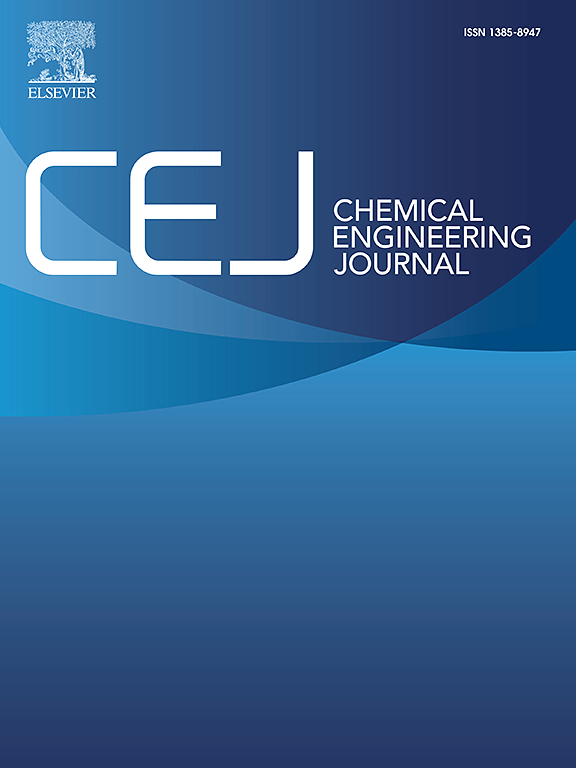Dual-pathway photosynthesis H2O2 realized by carbon nitride with strong built-in electric field and awakened n-π* electron transition: Based on theoretical calculation guidance
IF 13.2
1区 工程技术
Q1 ENGINEERING, CHEMICAL
引用次数: 0
Abstract
Utilizing metal-free and cost-effective carbon nitride (CN) photocatalyst to photosynthesize green and energy-intensive H2O2 from O2 and H2O is a promising solution to alleviate energy and environmental crises, while dual-pathway photosynthesis H2O2 and directional regulation light absorption and charge behaviors of CN are challenging. Herein, by preliminary theoretical calculation, 2, 3-diaminopiperazine is selected as dopant to construct CN with strong built-in electric field and broadened visible-light harvest. Based on calculation guidance, a super-hydrophilic CN bearing K+, cyano group, piperazine ring is tailored via strong ultrasonic field and molten-salt calcination assistance. As expected, strong built-in electric field (KPFM and SPV) and remarkable charges space separation (further DFT) are achieved, which significantly promote charge behaviors of CN. Meanwhile, n-π* electron transition is successfully induced (EPR, UV–vis DRS, PL, fs-TA and wavelength-dependent photosynthesis H2O2 experiment) by lone pair electrons of piperazine ring and abundant edge –NH2, which broadens visible light above 500 nm. Benefiting from ultrasonic and molten-salt calcination, specific surface area is enlarged from 61.1 m2 g−1 to 130.7 m2 g−1. Fully exposed active sites and abundant edge –NH2 (or superhydrophilicity) promote the formation of quasi-homogeneous photocatalytic systems (SEM/TEM/AFM and free deposition experiment). Furthermore, significantly improved O2 adsorption capacity, combined with dual-pathway mechanism for H2O2 photosynthesis (DFT, RDE, in-site FTIR), enable H2O2 photosynthesis rate of 8075 μmol g−1h−1. This work reveals the significant impact of synthetic method and theoretical calculation on CN activity, and offers comprehensive guidance for rational design of CN with tailored groups to fulfill specific requirements for artificial photosynthesis of H2O2.

氮化碳内建强电场和唤醒n-π*电子跃迁实现H2O2双途径光合作用:基于理论计算指导
利用无金属且经济高效的氮化碳(CN)光催化剂从O2和H2O中光合合成绿色高耗能的H2O2是缓解能源和环境危机的一种很有希望的解决方案,但双途径光合作用H2O2和CN的定向调节光吸收和电荷行为是一个挑战。本文通过初步的理论计算,选择2,3 -二氨基哌嗪作为掺杂剂,构建具有强内建电场和宽可见光收获的CN。在计算指导下,通过强超声场和熔盐辅助煅烧,定制了含K+、氰基、哌嗪的超亲水性CN。正如预期的那样,实现了强大的内置电场(KPFM和SPV)和显著的电荷空间分离(进一步的DFT),显著促进了CN的电荷行为。同时,哌啶环的孤对电子和丰富的边-NH2成功诱导n-π*电子跃迁(EPR, UV-vis DRS, PL, fs-TA和波长依赖的光合作用H2O2实验),使500 nm以上的可见光变宽。经超声和熔盐煅烧后,其比表面积由61.1 m2 g−1增大到130.7 m2 g−1。充分暴露的活性位点和丰富的边缘-NH2(或超亲水性)促进了准均相光催化体系的形成(SEM/TEM/AFM和自由沉积实验)。同时,结合H2O2光合作用的双途径机制(DFT、RDE、现场FTIR), H2O2的光合速率可达8075 μmol g−1h−1。这项工作揭示了合成方法和理论计算对CN活性的重要影响,为CN的合理设计提供了全面的指导,以满足H2O2人工光合作用的特定要求。
本文章由计算机程序翻译,如有差异,请以英文原文为准。
求助全文
约1分钟内获得全文
求助全文
来源期刊

Chemical Engineering Journal
工程技术-工程:化工
CiteScore
21.70
自引率
9.30%
发文量
6781
审稿时长
2.4 months
期刊介绍:
The Chemical Engineering Journal is an international research journal that invites contributions of original and novel fundamental research. It aims to provide an international platform for presenting original fundamental research, interpretative reviews, and discussions on new developments in chemical engineering. The journal welcomes papers that describe novel theory and its practical application, as well as those that demonstrate the transfer of techniques from other disciplines. It also welcomes reports on carefully conducted experimental work that is soundly interpreted. The main focus of the journal is on original and rigorous research results that have broad significance. The Catalysis section within the Chemical Engineering Journal focuses specifically on Experimental and Theoretical studies in the fields of heterogeneous catalysis, molecular catalysis, and biocatalysis. These studies have industrial impact on various sectors such as chemicals, energy, materials, foods, healthcare, and environmental protection.
 求助内容:
求助内容: 应助结果提醒方式:
应助结果提醒方式:


